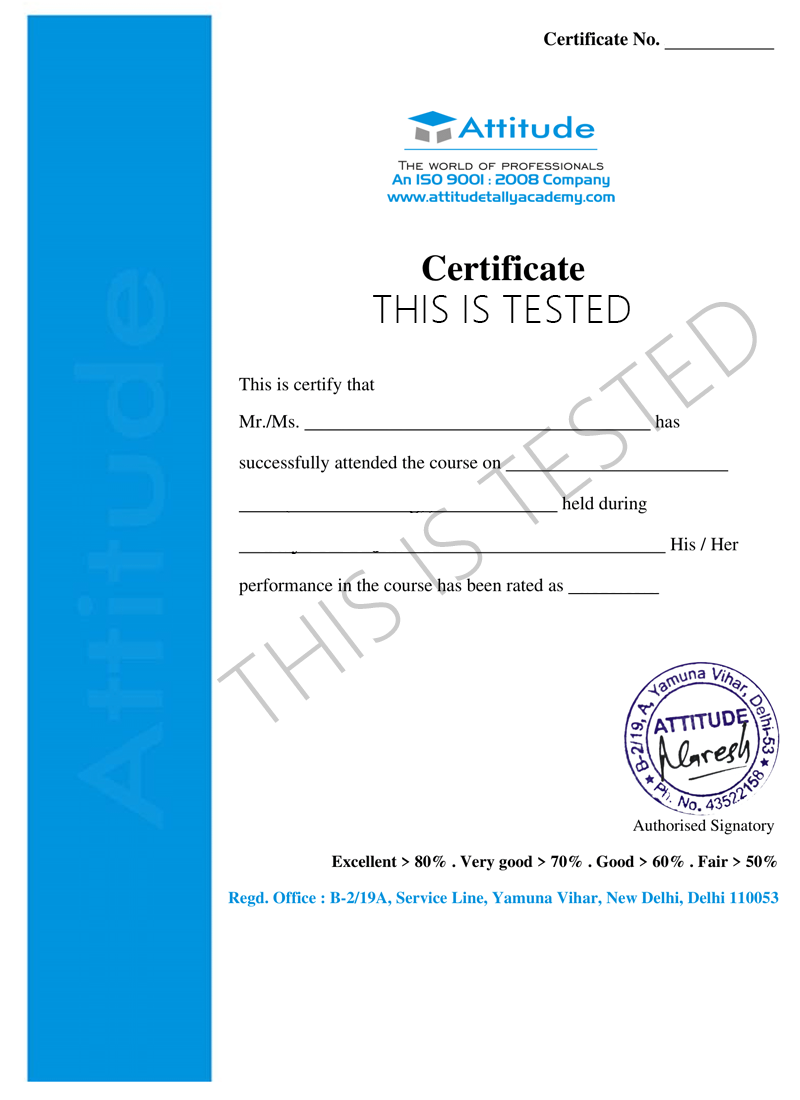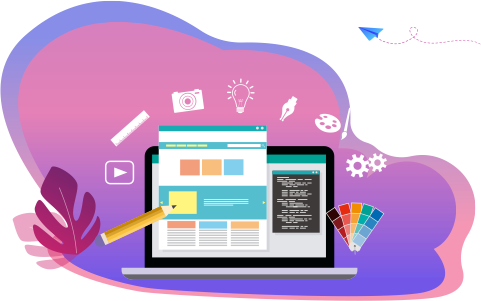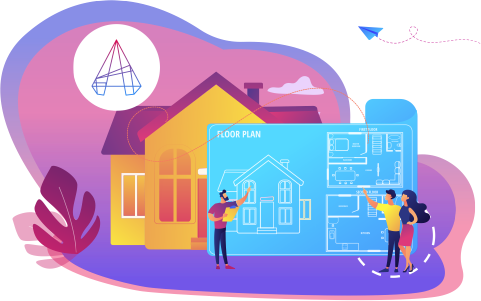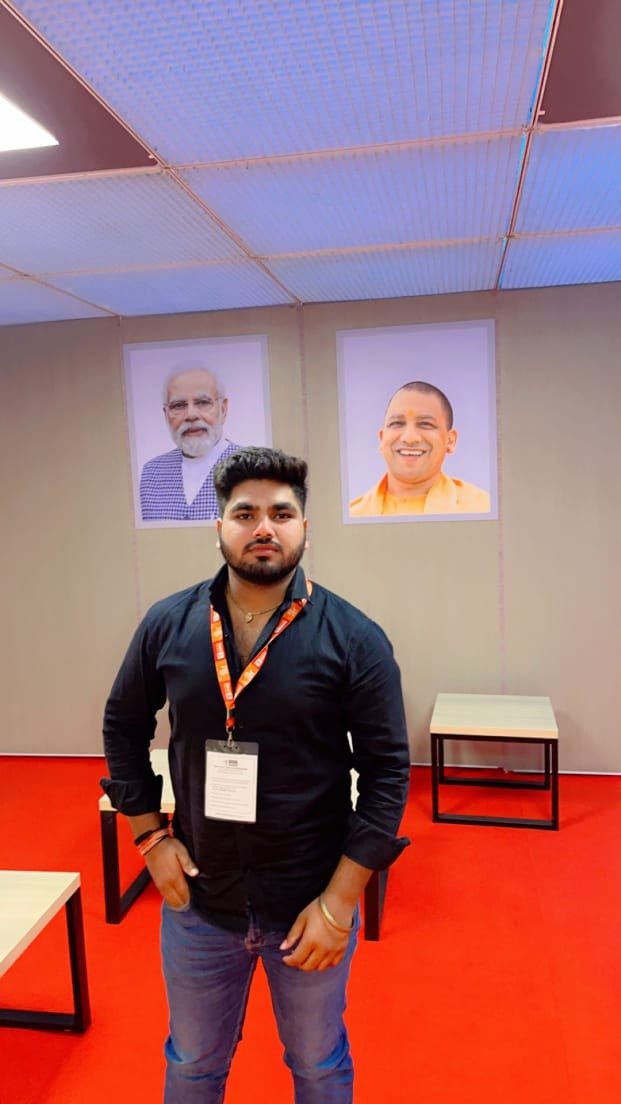- Combo Course
- BECOME AN IT PROFESSIONAL
Become Professional in Programming And Coding
Start Your Programming Journey With Attitude Academy. This Certification Is Key To Cracking Your Dream Job In The IT World.
- 10 - 20 weeks
- 102 Lectures
- 8097 Student Enrolled
- Offer by ATTITUDE ACADEMY
- Last updated:- Jan 8, 2024

₹699.00 96% Off
- Online Interactive Learning Sessions
- Practical Videos For Covering Course
- Complete eBook with Assignments
- Practice Project are also provided for practice
- Practice Projects based on actual business transaction
- Course Related Blogs & Articles
- 100% Job Assistance
- Access on All Device
- 24*7 Lifetime Access
- ISO 9001 : 2008 Company
- Internship Programme for Learners
- Govt. Recognized Certificate
- One of the Finest Education Brand in India
What you'll learn
- C Programming
- C++ Programming
- Python
- Advanced Data Structures
- DBMS
- Software Engineering
Requirements
You must be a little familiar with Computer.
What placement assistance will you receive?

Free Placement Preparation Training

Access to curated Internships & Current Job Openings.

Top performers will be highlighted on Attitude Job portal
Requirements
Start your programming journey with Attitude Academy. This certification is key to cracking your dream job in the IT world. Become proficient in the concepts of Programming in C, C++, strings and structures, functions, pointers, widely-used algorithms, and many more. Upskill in an elective coding language of your choice (Python or Java) based on your career goals.
Course Circullum
MODULE-I INTRODUCTION OF C LANGUAGE
- Introduction of C language
- Feature of C language
- Getting Start
- How Create Hello World Program
- How Compile And Run And Save The Program
- Taking Input From User
- Output
MODULE-II TOKEN C LANGUAGE
- What Is Token
- Data Type
- Keyword
- Indefifers
- Literals
- Opearators
- Separators
MODULE-III SEQUENCE CONTROL & DECISION MAKING STATMENT
- 5 basic program for beginners
- If
- If Else
- If else if else
- Nested if else
MODULE-IV LOOPING & JUMP STATMENTS
- While
- Do while
- For
- Nested Loops
- Break
- Continue
- Goto
MODULE-V ARRAY, STRUCTURE, UNION & STRING
- 1d
- 2d
- Creation of Structure n object
- Nested structure
- Array of object
- Discuss Unions
- Create Union variable
- Access Union member using . operator
- Discuss Unions of Structures
- Compare Structure and Array
- Difference between structure & union
- Character represent in single quotes while String represent in double
- quotes example str=‘M’ →Character Constant , str=“AMIT”→String
- Constant .
- String is Collection of Character
- String is also Knows as 1D Character ARRAY
- Every String end with ‘\0’ i.e. called NULL.
MODULE-VI FUNCTIONS & POINTERS
- Explain Type of Functions
- Discuss category of Functions
- Declaration & Prototypes
- Explain User Defined Functions
- Calling the Function
- What is meant by pointer is and why it can ne used?
- How to Declare and access a pointer variable
- Explain Pointer Increment/Decrement
- Explain the use of pointers with arrays
- Explain How Pointer To Functions can be used
- Explain Pointers to Structures can be used
MODULE-VII DYNAMIC MEMORY ALLOCATION IN C
-
Dynamic memory allocation in C
-
The concept of dynamic memory allocation in c language enables the
-
C programmer to allocate memory at runtime.
-
Dynamic memory allocation in c language is possible by 4 functions of stdlib.h header file.
-
malloc()
-
calloc()
-
realloc()
-
free()
MODULE-I INTRODUCTION OF C++
- C++ Basic Programming
- Introduction Of C++
- C++ Language Fundamentals
MODULE-II OPERATORS
C++ language provides the following types of operators:
- Arithmetic Operators
- Relational Operators
- Logical Operators
- Assignment Operator
- Bitwise Operators
- Ternary Operator
MODULE-III LOOPS, CONDITIONAL STATEMENTS & ACCESS MODIFIERS
- while loop
- for loop
- do while loop
- nested loops
- if statement
- if- else
- Nested-if
- if-else-if ladder
- Switch Statement in C++
- Syntax
- Public
- Private
- Protected
MODULE-IV ARRAY, FUNCTION, CONSTRUCTOR, POLYMORPHISM & INHERITANCE
- 1D Array
- 2D Array
- Introduction of Constructor
- Declaring constructors
- Writing constructors
- Using constructors
- Constructors Overloaded
- Polymorphism
- Types of inheritance in C++
- Visibility mode in Derived class
- single inheritance
- C++ Multilevel Inheritance
- multiple inheritance
- Hybrid Inheritance
- hierarchical inheritance.
MODULE-V FUNCTION, POINTERS, STRUCTURE & FILE HANDLING
- Function Overloading
- Operator Overloading
- Abstract
- Difference virtual and pure virtual
- Introduction to Pointer
- Use of Pointer
- Null Pointer
- Increment/ Decrement Pointer
- Pointer to Pointer
- Pointer to Function
- How to use Structure?
- Structure with array
- Nested Structure
- Passing Structure by Value
- Passing Structure by Reference
- Union
- C - Pointer arithmetic
- Difference between text file and binary file
- Operations in File Handling
- File Opening Modes
- Creating/Opening a File
- Writing to a File
- Special operations in a File
MODULE-VI EXCEPTION HANDLING
- What Is Exception Handling?
- Error In Exception Handling
- User-Defined Exceptions
MODULE-I INTRODUCTION TO DATA STRUCTURES
- Introduction to Data Structures
- Getting start with Data Structures
MODULE-II ANALYSIS OF AGLORITHM & ARRAY
- Mathematical Background
- Process of Analysis
- Calculation of Storage Complexity
- Calculation of Run Time Complexity
- Arrays and Pointers
- Sparse Matrices
- Polynomials
- Representation of Arrays
- Row Major Representation
- Column Major Representation
- Applications
- Representation of single and multidimensional arrays in Code Blocks
MODULE-III LINKED LIST, STACK(LAB), QUEUES, DEQUE(LAB)
- Linked List and its types and applications
- Linked List implementation using array
- Implementation of Doubly Linked List
- Implementation of Circularly Linked Lists
- STL
- application of stack
- Implementation of Stack
- Implementation of Stack using array
- Implementation of stack using Linked List
- Types
- Application of queue
- Implementation of Queue
- Array Implementation
- Linked List Implementation of Queue
- Implementation of circular queues(Array)
- Implementation of circular queues(Linked List)
- Implementation of Deque(array)
MODULE-IV TREE, BINARY TREE, BST(LAB + THEORY), AVL TREE
- Tree traversal methods
- Tree and its implementation
- Implementation of Binary Tree
- Recursive Implementation of Binary Tree Traversals
- Non Recursive Implementations of Binary Tree
- Intro to Binary Search Tree
- Traversing a BST
- Insertion in BST
- Deletion in BST
- Intro and balancing in AVL Application
- Implementation AVL insertion
- Deletion in AVL
MODULE-V GRAPHS, SEARCHING METHODS, SORTINGS
- Graphs with Negative Edge costs
- Acyclic Graphs
- All Pairs Shortest Paths Algorithm
- Minimum cost Spanning Trees
- Kruskals Algorithm
- Primss Algorithm
- Finding Strongly Connected Components
- Linear Search
- Binary Search
- Applications of types of search
- Internal Sorting
- Insertion sort
- Insertion Sort
- Bubble Sort
- Quick Sort
- 2 Way Merge sort
- Sorting on Several Key
MODULE-VI ADVANCE DS & FILE STRUCTURE
- Splay Tree Intro
- Splaying Steps and Algorithm
- Red Black Trees and Properties
- Insertion in Red Black tree
- Deletion in Red black Tree
- Terminology
- File Organisation
- Sequential Files
- Structure
- Operations
- Disadvantages
- Areas of use
- Direct File Organisation
- Indexed Sequential File Organisation
MODULE-I INTRODUCTION OF PYTHON & TOKEN
- What is Python How to Install
- Introduction of Python
- First Program in python
- Identifiers
- Operators
- Keywords
- Delimiters
- Literals
MODULE-II OPERATORS
- Arithmetic Operators
- Comparison Operators
- Assignment Operators
- Logical Operators
- Bitwise Operators
- Membership Operators
- Identity Operators
- Ternary Operator
MODULE-III PYTHON COMMENTS
- Comments can be used to explain Python code
- Comments can be used to make the code more readable
- Comments can be used to prevent execution when testing code
- Comments can be used to Internal documents source code
- Types of Comments in Python
- Python block comments
MODULE-IV DECISION MAKING STATEMENT, ITERATION, JUMP STATEMENTS
- If Statement
- If else statement
- If elif else statement
- Nested if else statement
- For Loop
- While Loop
- Nested Loop
- Break Statement
- Continue statement
- Pass statement
MODULE-V STRING & LISTS
- What is String
- Creating & Declaring String Empty String & Multiline Strings
- String Traversing
- String Operators
- Concatenating String
- Replicating String
- Membership Operators
- Comparison Operators
- String Slicing
- String are Immutable
- String Method and Built in Functions
- What is List
- Declaring & creating list
- Accessing List elements
- Traversing a list
- Comparing lists
- Operations on lists
- Concatenation
- Replication
- Membership
- Indexing
- Slicing
- Bulit in Functions
MODULE-VI DICTIONARY & MODULES
- Introduction
- Method to create a Dictionary
- Accessing elements in Dictionary
- Traversing a dictionary
- Appending values in a dictionary
- Removing an item from dictionary
- In and not in membership operator in dictionary
- Functions and Methods in dictionary
- Count Frequency of elements in list using Dictionary
- WHAT IS Module
- Importing Python Modules
- Built in Functions
MODULE-VII TUPLES, FUNCTION & DATA STRUCTURES
- What Is Tuples?
- Basic Tuples Operations
- Tuple Functions
- Tuple Accessing Elements
- Data Structures
- Stack In Data Structure
- Queue In Data Structure
- Date And Time
- Function Introduction
- Function Arguments
- Local Global Variable In Functions
- What Is Numpy
- 2D Array In Numpy
MODULE-I INTRODUCTION & OBJECT
-
What is DNMS
-
Why we need Database management system
-
Importants of DBMS?
-
Objectives Of DBMS?
MODULE-II NEED & LOGICAL OF DBMS
-
The file based system
-
Limitations of file based system
-
The Database Approach
-
Three level architecture of DBMS or logical DBMS architecture
-
Mappings between levels and data independence
-
The need for three level architecture
MODULE-III PHYSICAL DBMS ARCHITECTURE
-
DML Precompiler
-
DDL Compiler
-
File Manager
-
Database Manager
-
Query Processor
-
Database Administrator
-
Data files indices and Data Dictionary
-
Commercial Database Architecture
-
Data Models
MODULE-V RELATIONAL & E-R MODELS
-
Introduction
-
Objectives
-
The Relational Model
-
Domains, Attributes Tuple and Relation
-
Super keys Candidate keys and Primary keys for the Relations
-
Relational Constraints 27
-
Domain Constraint
-
Key Constraint
-
Integrity Constraint
-
Update Operations and Dealing with Constraint Violations
-
Relational Algebra 31
-
Basic Set Operation
-
Cartesian Product
-
Relational Operations
-
Entity Relationship (ER) Model 38
-
Entities
-
Attributes
-
Relationships
-
More about Entities and Relationships
-
Defining Relationship for College Database
-
E-R Diagram 44
-
Conversion of E-R Diagram to Relational Database
MODULE-VI DATABASE INTEGRITY & NORMALIZATION
-
Introduction
-
Objectives
-
Relational Database Integrity
-
The Keys
-
Referential Integrity
-
Entity Integrity
-
Redundancy and Associated Problems 62
-
Single-Valued Dependencies 64
-
Single-Valued Normalization 66
-
The First Normal Form
-
The Second Normal Form
-
The Third Normal Form
-
Boyce Codd Normal Form
-
Desirable Properties of Decomposition 72
-
Attribute Preservation
-
Lossless-join Decomposition
-
Dependency Preservation
-
Lack of redundancy
-
Rules of Data Normalization 74
-
Eliminate Repeating Groups
-
Eliminate Redundant Data
-
Eliminate Columns Not Dependent on Key
MODULE-VII FILE ORGANISATION IN DBMS
-
Introduction 80
-
Objectives 81
-
Physical Database Design Issues 81
-
Storage of Database on Hard Disks 82
-
File Organisation and Its Types 83
-
Heap files (Unordered files)
-
Sequential File Organisation
-
Indexed (Indexed Sequential) File Organisation
-
Hashed File Organisation
-
Types of Indexes 87
-
Index and Tree Structure 97
-
Multi-key File Organisation99
-
Need for Multiple Access Paths
-
Multi-list File Organisation
-
Inverted File Organisation
-
Importance of File Organisation in Databases 103
MODULE-I INTRODUCTION OF SOFTWARE ENGINEERING
-
Software Processes
-
SDLC
-
SDLC Models
-
Requirement Engineering
MODULE-II MODELS
-
Waterfall Model
-
RAD Model
-
Spiral Model
-
V-model
-
Incremental Model
-
Agile Model
-
Iterative Model
-
Big-Bang Model
-
Prototype Model
MODULE-III SOFTWARE MANAGEMENT & SOFTWARE METRICS
-
Project Management
-
Activities
-
Project Management Tools
-
Software Management
-
Software Metrics
-
Size Oriented Metrics
-
Halstead's Software Metrics
-
Functional Point (FP) Analysis
-
Extended Function Point (EFP) Metrics
-
Data Structure Metrics
-
Information Flow Metrics
-
Cyclomatic Complexity
-
Case Tools For Software Metrics
MODULE-IV PROJECT PLANNING & RISK MANAGEMENT
-
Software Project Planning
-
Software Cost Estimation
-
COCOMO Model
-
Putnam Resource Allocation Model
-
Risk Management
-
Risk Management Activities
-
Project Scheduling
-
Personnel Planning
-
Software Requirement
-
Software Requirement Specifications
-
Requirements Analysis
-
Data Flow Diagrams
-
Data Dictionaries
-
Entity-Relationship Diagram
-
S/W Configuration
-
Software Configuration Management
-
SCM Process
-
Software Quality Assurance
-
Project Monitoring & Control
MODULE-V SOFTWARE QUALITY & SOFTWARE DESIGN
-
Software Quality
-
ISO 9000 Certification
-
SEICMM
-
PCMM
-
Six Sigma
-
Software Design
-
Software Design Principles
-
Coupling and Cohesion
-
Function Oriented Design
-
Object Oriented Design
-
User Interface Design
-
Coding
-
Programming Style
-
Structured Programming
MODULE-VI SOFTWARE RELIABILITY
-
Software Reliability
-
Software Failure Mechanisms
-
Software Reliability Measurement Techniques
-
Software Reliability Metrics
-
Software Fault Tolerance
-
S. Reliability Models
-
Software Reliability Models
-
Jelinski & Moranda Model
-
Basic Execution Time Model
-
Goel-Okumoto (GO) Model
-
Musa-Okumoto Logarithmic Model
-
Software Maintenance
-
Causes of Software Maintenance Problems
-
Software Maintenance Cost Factors
How will your training work?

Classes
Watch recorded & live videos to learn various concepts & get Live Sessions with Trainer for Doubts Clearing.

Exams
Test your knowledge through quizzes & module tests. Take online exam & get instant result.

Projects
Get hands on practice by doing assignments and live project

Certificate
Take the final exam to get certified in Become Professional in Programming And Coding
Reviews - 0
Releated Courses

₹699.00 ₹18999.00
96% Off
Coupon Code: OFF10COURSE
- Online Interactive Learning Sessions
- Practical Videos For Covering Course
- Complete eBook with Assignments
- Practice Project are also provided for practice
- Practice Projects based on actual business transaction
- Course Related Blogs & Articles
- 100% Job Assistance
- Access on All Device
- 24*7 Lifetime Access
- ISO 9001 : 2008 Company
- Internship Programme for Learners
- Govt. Recognized Certificate
- One of the Finest Education Brand in India
How will your doubts get solved?

You can post your doubts on the Q&A forum which will be answered by the teachers within 24 hours.
100% Placement Assistance
Meet Our Placed Students
Commonly Asked Questions
Q. What are the prerequisites for the training?
There are no prerequisites for this training as it is of beginner level. Everything that you need to know about Become Professional in Programming And Coding would be taught to you from scratch.
Q. Do I need to have a laptop or desktop to do the training or can I do it on mobile too?
You can watch the videos and take quizzes & tests on any device including mobile. However, for assignments and practice, use of desktop or laptop is required.
Q. What system configuration is needed to do this training?
Q. When can I start the training?
You can choose your preferred batch date while signing up for the training program and start accordingly.
Q. Will I be getting a hard copy of the certificate?
No, you will be only getting a soft copy of the certificate which you can download and print out if required.
Q. What placement assistance will I receive from Attitude as part of the training?
- You will receive free access to Placement Preparation Training on the platform which covers resume writing, cover letter writing, how to search and apply for internships and jobs on Attitude, and interview preparation. This training comes with a lifetime access meaning you can use it later also if you are not applying for internships or jobs right now.
- Access to curated internships & jobs related to the training - after completing the training, you would receive a list of handpicked internships or jobs every week that you can apply to as per your preference.
- If you are a top performer, a badge of achievement will be added to your Attitude resume and shown to the employers when you apply to internships or jobs on Attitude.
Q. Does Attitude Trainings guarantee a job or internship placement?
While many of our students have found their desired internships or jobs after completing their training, Attitude Trainings does not guarantee an internship or job. However, if you study sincerely (including doing exercises, assignments, and projects) and make good use of our placement assistance feature, it will become easier for you to get a placement using the skills learned in the training.
Q. I’m not able to make payment. What should you do now?
You could try making the payment from a different card or account (of a friend or family). Otherwise, you can follow the instructions on how to make an offline payment.
Q. The payment shows failed but money got deducted? What should I do now?
The amount deducted will come back to your account within 3-5 working days. This is the normal duration your bank will take to credit the amount back into your account.











.png)


